Home»
CAAS offers boutique PhD education
Over 50 international PhD students from the Chinese Academy of Agricultural Sciences (CAAS) visited the CAAS-Daxing International Cooperation Base for Agricultural Research and Development (CDICB) in southern Beijing on Oct 13.
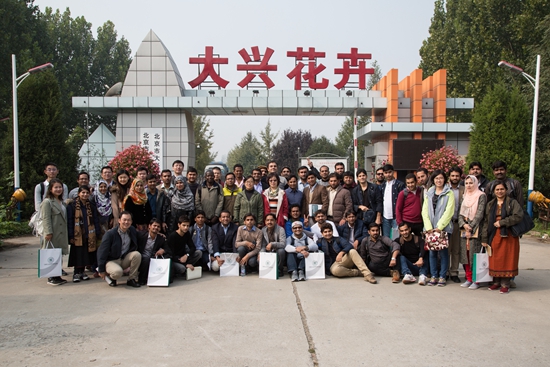
They first visited the Daxing Plant Nursery to study ornamental plants such as anthurium scherzeranum and marantaceae. They then went to the Daxing Agricultural Technology Extension Station to learn about intelligent control systems for protected agriculture and other technologies.
This year, over a hundred international PhD students came to CAAS. Their research fields range from horticulture and entomology to biochemistry.
"The field trip was very informative. I was especially impressed with the Active Heat Storage-Release System for Greenhouse. I will learn more and apply that technology in my country," said Alia Anwar, one of the students.
Field trips like this are arranged to complement theories the students learn in class. They are also expected to inspire the PhD candidates in choosing topics for their theses. And more important, obviously it is beneficial for the foreign PhD candidates to have a better understanding on China’s modern agriculture and its development.
The CAAS PhD program for international students lasts three years. The students study in Beijing for four months before going to institutes across China affiliated with the program.
Most candidates receive scholarships granted by the Chinese Government, the Beijing Municipal Government or CAAS.
CAAS now offers field trips on a regular basis. It arranges visits to agricultural museums, expo gardens and similar venues so that the students can learn more about Chinese agriculture.
"The scale is not that big; CAAS’ graduate school is devoted to providing a boutique PhD education for international students," said Zhang Mingjun, deputy director of the school’s international education department.
Founded in 1979, the graduate school of the Chinese Academy of Agricultural Sciences was one of the earliest post-graduate degree-granting institutions in China.
In 2007, it was authorized by the Ministry of Education to accept international students under the Chinese Government Scholarship (CGS) program. In 2008, the first 11 foreign students were admitted; today, over 150 foreign students are enrolled.
GSCAAS places a great deal of emphasis on the development of international education. It has established various bilateral exchanges and cooperation with agricultural research institutions, universities and colleges from more than 60 countries and regions, and has carried out cooperative PhD Programs with the University of Liège in Belgium, Wageningen University in the Netherlands and other world famous universities.
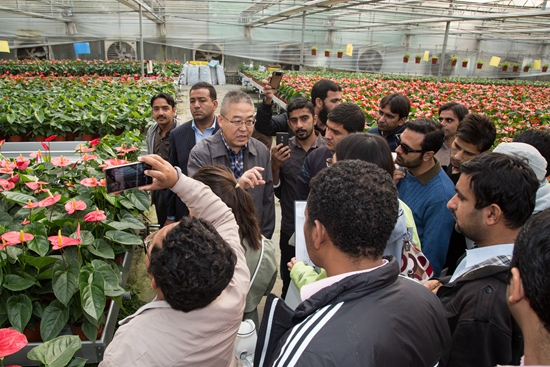
An expert explains the varieties of Anthurium to CAAS PhD students at the CAAS-Daxing International Cooperation Base for Agricultural Research and Development on Oct 13. [Photo by Su Ning/ Chinese Academy of Agricultural Sciences]
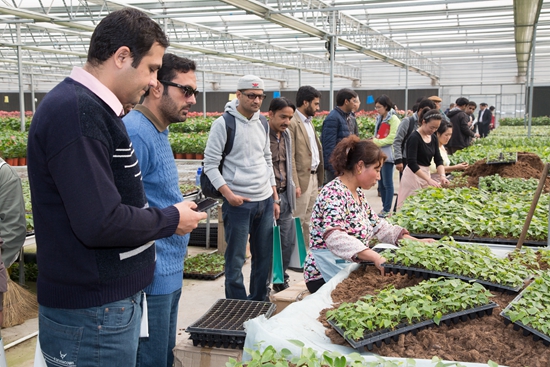
Students watch workers sort plants at a greenhouse at the CAAS-Daxing international cooperation base. [Photo by Su Ning/ Chinese Academy of Agricultural Sciences]
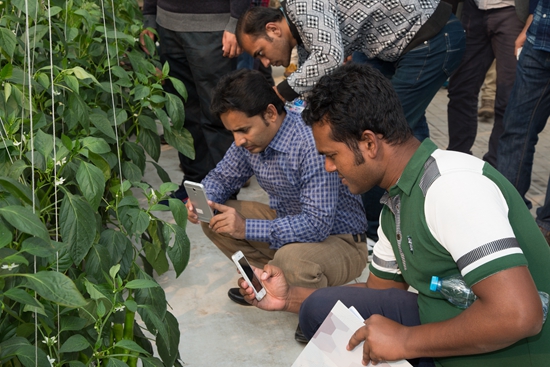
Photos of plants are useful for future study. CAAS PhD students take some at the international cooperation base for Agricultural Research and Development on Oct 13. [Photo by Su Ning/ Chinese Academy of Agricultural Sciences]
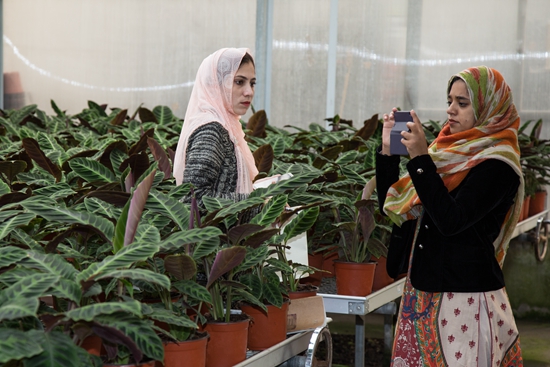
A CAAS PhD student from Pakistan takes a photo of Maranraceae. [Photo by Su Ning/ Chinese Academy of Agricultural Sciences]

Over 50 CAAS PhD students from 23 countries visit Daxing Plant Nursery on Oct 13. [Photo by Su Ning/ Chinese Academy of Agricultural Sciences]
They first visited the Daxing Plant Nursery to study ornamental plants such as anthurium scherzeranum and marantaceae. They then went to the Daxing Agricultural Technology Extension Station to learn about intelligent control systems for protected agriculture and other technologies.
This year, over a hundred international PhD students came to CAAS. Their research fields range from horticulture and entomology to biochemistry.
"The field trip was very informative. I was especially impressed with the Active Heat Storage-Release System for Greenhouse. I will learn more and apply that technology in my country," said Alia Anwar, one of the students.
Field trips like this are arranged to complement theories the students learn in class. They are also expected to inspire the PhD candidates in choosing topics for their theses. And more important, obviously it is beneficial for the foreign PhD candidates to have a better understanding on China’s modern agriculture and its development.
The CAAS PhD program for international students lasts three years. The students study in Beijing for four months before going to institutes across China affiliated with the program.
Most candidates receive scholarships granted by the Chinese Government, the Beijing Municipal Government or CAAS.
CAAS now offers field trips on a regular basis. It arranges visits to agricultural museums, expo gardens and similar venues so that the students can learn more about Chinese agriculture.
"The scale is not that big; CAAS’ graduate school is devoted to providing a boutique PhD education for international students," said Zhang Mingjun, deputy director of the school’s international education department.
Founded in 1979, the graduate school of the Chinese Academy of Agricultural Sciences was one of the earliest post-graduate degree-granting institutions in China.
In 2007, it was authorized by the Ministry of Education to accept international students under the Chinese Government Scholarship (CGS) program. In 2008, the first 11 foreign students were admitted; today, over 150 foreign students are enrolled.
GSCAAS places a great deal of emphasis on the development of international education. It has established various bilateral exchanges and cooperation with agricultural research institutions, universities and colleges from more than 60 countries and regions, and has carried out cooperative PhD Programs with the University of Liège in Belgium, Wageningen University in the Netherlands and other world famous universities.

An expert explains the varieties of Anthurium to CAAS PhD students at the CAAS-Daxing International Cooperation Base for Agricultural Research and Development on Oct 13. [Photo by Su Ning/ Chinese Academy of Agricultural Sciences]

Students watch workers sort plants at a greenhouse at the CAAS-Daxing international cooperation base. [Photo by Su Ning/ Chinese Academy of Agricultural Sciences]

Photos of plants are useful for future study. CAAS PhD students take some at the international cooperation base for Agricultural Research and Development on Oct 13. [Photo by Su Ning/ Chinese Academy of Agricultural Sciences]

A CAAS PhD student from Pakistan takes a photo of Maranraceae. [Photo by Su Ning/ Chinese Academy of Agricultural Sciences]